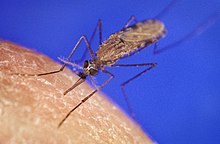| Anopheles gambiae | |
|---|---|

| |
| Scientific classification | |
| Kingdom: | |
| Phylum: | |
| Class: | |
| Order: | |
| Family: | |
| Subfamily: | |
| Genus: | |
| Species complex: | A. gambiae sensu lato
|
| Species: |
|
| Binomial name | |
| Anopheles gambiae | |

The Anopheles gambiae complex consists of at least seven morphologically indistinguishable species of mosquitoes in the genus Anopheles. The complex was recognised in the 1960s and includes the most important vectors of malaria in sub-Saharan Africa, particularly of the most dangerous malaria parasite, Plasmodium falciparum.[2] It is one of the most efficient malaria vectors known. The An. gambiae mosquito additionally transmits Wuchereria bancrofti which causes lymphatic filariasis, a symptom of which is elephantiasis.[3]
- ^ Giles, G. M. (1902). A handbook of the gnats or mosquitoes giving the anatomy and life history of the Culicidae together with descriptions of all species noticed up to the present date. London, United Kingdom: John Bale, Sons & Danielsson.
- ^ "Anopheles gambiae complex". Walter Reed Army Institute of Research. Archived from the original on 2007-09-29.
- ^ "Lymphatic filariasis". www.who.int. Retrieved 2020-04-10.